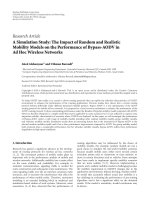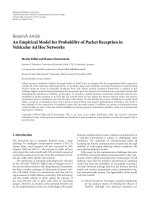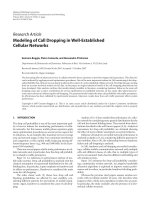Analysis and correction of voltage profile in low voltage distribution networks containing photovoltaic cells and electric vehicles
Bạn đang xem bản rút gọn của tài liệu. Xem và tải ngay bản đầy đủ của tài liệu tại đây (1.97 MB, 216 trang )
Analysis and Correction of Voltage
Profile in Low Voltage Distribution
Networks Containing Photovoltaic
Cells and Electric Vehicles
Farhad SHAHNIA
B.Sc, M.Sc in Electrical Engineering
A Thesis submitted in partial fulfillment of the requirements for the degree of
Doctor of Philosophy
Faculty of Built Environment and Engineering
School of Engineering Systems
Queensland University of Technology
Queensland, Australia
August 2011
Keywords
Low Voltage Distribution Networks, Voltage Profile, Voltage Unbalance,
Photovoltaic Cells, Single–phase rooftop PVs, Plug–in Electric Vehicles, Micro
Grid, DSTATCOM, DVR, Sensitivity Analysis, Stochastic Evaluation
i
Abstract
Voltage drop and rise at network peak and off–peak periods along with voltage
unbalance are the major power quality problems in low voltage distribution
networks. Usually, the utilities try to use adjusting the transformer tap changers as a
solution for the voltage drop. They also try to distribute the loads equally as a
solution for network voltage unbalance problem.
On the other hand, the ever increasing energy demand, along with the necessity
of cost reduction and higher reliability requirements, are driving the modern power
systems towards Distributed Generation (DG) units. This can be in the form of small
rooftop photovoltaic cells (PV), Plug–in Electric Vehicles (PEVs) or Micro Grids
(MGs). Rooftop PVs, typically with power levels ranging from 1–5 kW installed by
the householders are gaining popularity due to their financial benefits for the
householders. Also PEVs will be soon emerged in residential distribution networks
which behave as a huge residential load when they are being charged while in their
later generation, they are also expected to support the network as small DG units
which transfer the energy stored in their battery into grid. Furthermore, the MG
which is a cluster of loads and several DG units such as diesel generators, PVs, fuel
cells and batteries are recently introduced to distribution networks.
The voltage unbalance in the network can be increased due to the uncertainties
in the random connection point of the PVs and PEVs to the network, their nominal
capacity and time of operation. Therefore, it is of high interest to investigate the
voltage unbalance in these networks as the result of MGs, PVs and PEVs integration
to low voltage networks. In addition, the network might experience non–standard
iii
voltage drop due to high penetration of PEVs, being charged at night periods, or
non–standard voltage rise due to high penetration of PVs and PEVs generating
electricity back into the grid in the network off–peak periods.
In this thesis, a voltage unbalance sensitivity analysis and stochastic evaluation
is carried out for PVs installed by the householders versus their installation point,
their nominal capacity and penetration level as different uncertainties. A similar
analysis is carried out for PEVs penetration in the network working in two different
modes: Grid to vehicle and Vehicle to grid. Furthermore, the conventional methods
are discussed for improving the voltage unbalance within these networks. This is
later continued by proposing new and efficient improvement methods for voltage
profile improvement at network peak and off–peak periods and voltage unbalance
reduction. In addition, voltage unbalance reduction is investigated for MGs and new
improvement methods are proposed and applied for the MG test bed, planned to be
established at Queensland University of Technology (QUT). MATLAB and
PSCAD/EMTDC simulation softwares are used for verification of the analyses and
the proposals.
iv
Table of Contents
List of Figures .............................................................. ix
List of Tables ..............................................................xiii
List of Appendices....................................................... xv
List of principle symbols and abbreviations .......... xvii
Statement of original authorship .............................. xix
Acknowledgements .................................................... xxi
Chapter 1: Introduction ............................................. 1
1.1 Background ........................................................................................................ 1
1.1.1 Rooftop PVs ................................................................................................ 2
1.1.2 Plug–in electric vehicles ............................................................................. 4
1.1.3 Micro grids .................................................................................................. 6
1.1.4 Demand side management .......................................................................... 7
1.2 Aims and objectives of the thesis ....................................................................... 9
1.3 Significance of research ..................................................................................... 9
1.4 The original contributions of the research ....................................................... 10
1.5 Structure of the thesis ....................................................................................... 10
Chapter 2: Operation and Control of a Hybrid
Micro grid with Unbalanced and
Nonlinear Loads .................................... 13
2.1 Micro grid structure.......................................................................................... 13
2.2 Effect of compensating DG location ................................................................ 14
2.3 Droop control methods in micro grid ............................................................... 16
2.4 Compensator control ........................................................................................ 17
2.4.1 Mode I ....................................................................................................... 18
2.4.2 Mode II ...................................................................................................... 19
2.5 Converter structure ........................................................................................... 19
2.5.1 Compensator VSC structure...................................................................... 20
2.5.2 VSC structure of other DGs ...................................................................... 22
2.6 Modeling of micro grid .................................................................................... 22
2.6.1 Fuel Cell (FC) ........................................................................................... 22
2.6.2 Photovoltaic cell (PV) ............................................................................... 24
v
2.6.3 Battery ....................................................................................................... 26
2.7 Study case and simulation results..................................................................... 26
2.7.1 Compensator principle operation .............................................................. 26
2.7.2 Power sharing in micro grid ...................................................................... 28
2.7.3 Micro grid with nonlinear load.................................................................. 31
2.7.4 Micro grid supplying single–phase residential loads ................................ 34
2.8 Summary .......................................................................................................... 37
Chapter 3: Voltage Unbalance Analysis in
Residential Low Voltage Distribution
Networks with Rooftop PVs ................. 39
3.1 Voltage profile and voltage unbalance ............................................................. 39
3.2 Voltage unbalance in LV distribution networks with PVs ............................... 41
3.2.1 Network structure ...................................................................................... 42
3.2.2 Power flow analysis .................................................................................. 42
3.2.3 Sensitivity analysis .................................................................................... 44
3.2.4 Stochastic evaluation ................................................................................. 44
3.3 Numerical results.............................................................................................. 46
3.3.1 Sensitivity analysis of a single PV on voltage unbalance ......................... 49
3.3.2 Mutual effect of PVs on voltage unbalance .............................................. 52
3.3.3 Stochastic evaluation of voltage unbalance .............................................. 56
3.4 Summary .......................................................................................................... 60
Chapter 4: Voltage Unbalance Improvement
Methods.................................................. 61
4.1 Methods ............................................................................................................ 61
4.1.1 Increasing feeder cross–section ................................................................. 61
4.1.2 Capacitor installation................................................................................. 61
4.1.3 Cross–section increase and capacitor installation ..................................... 62
4.1.4 New control scheme for PV converters..................................................... 62
4.2 Numerical results.............................................................................................. 64
4.3 Summary .......................................................................................................... 68
Chapter 5: Application of Custom Power Devices
for Voltage Unbalance Reduction in Low
Voltage Distribution Networks with
Rooftop PVs ........................................... 69
5.1 Network under consideration ........................................................................... 69
5.2 Custom power devices ..................................................................................... 71
5.2.1 DSTATCOM ............................................................................................. 71
5.2.2 DVR .......................................................................................................... 72
5.2.3 Structure and connection type ................................................................... 74
vi
5.2.4 VSC control............................................................................................... 74
5.3 Numerical analysis ........................................................................................... 76
5.3.1 Nominal case ............................................................................................. 77
5.3.2 DSTATCOM application .......................................................................... 78
5.3.3 DVR application ....................................................................................... 81
5.3.4 Stochastic analysis .................................................................................... 83
5.3.5 Semi–urban LV network ........................................................................... 86
5.4 Simulation results ............................................................................................. 88
5.4.1 DSTATCOM dynamic performance ......................................................... 88
5.4.2 DVR dynamic performance ...................................................................... 91
5.4.3 Multi–DVRs in semi–urban networks ...................................................... 92
5.5 Summary .......................................................................................................... 94
Chapter 6: Decentralized Local Voltage Support of
Low Voltage Distribution Networks with
a New Control Strategy of PVs ............ 95
6.1 Analysis ............................................................................................................ 95
6.2 PV Control strategies ....................................................................................... 98
6.2.1 Strategy–1: UPF strategy .......................................................................... 98
6.2.2 Strategy–2: Constant PQ strategy ............................................................. 99
6.2.3 Strategy–3: Voltage control strategy......................................................... 99
6.3 Numerical and dynamic modeling ................................................................. 101
6.3.1 Load flow analysis .................................................................................. 101
6.3.2 UPF strategy ............................................................................................ 102
6.3.3 Constant PQ strategy ............................................................................... 103
6.3.4 Voltage control strategy .......................................................................... 103
6.3.5 PV and converter dynamic modeling and MPPT algorithm ................... 104
6.4 Numerical analysis ......................................................................................... 105
6.4.1 Off–peak period ...................................................................................... 106
6.4.2 Peak period .............................................................................................. 107
6.5 Dynamic simulations...................................................................................... 110
6.5.1 Peak period .............................................................................................. 110
6.5.2 Off–peak period ...................................................................................... 114
6.6 Summary ........................................................................................................ 116
Chapter 7: Predicting Voltage Unbalance Impacts
of Plug–in Electric Vehicles Penetration
in Residential LV Distribution
Networks: Analysis and Improvement
............................................................... 117
7.1 Plug–in electric vehicles ................................................................................ 117
7.2 Modeling and analysis ................................................................................... 118
vii
7.2.1 Load flow and sensitivity analysis .......................................................... 119
7.2.2 Stochastic analysis................................................................................... 121
7.3 Analysis numerical results ............................................................................. 123
7.3.1 Sensitivity analysis of a single PEV on VU ............................................ 124
7.3.2 Mutual effect of PEVs on VU ................................................................. 127
7.3.3 C. Stochastic evaluation of VU ............................................................... 131
7.4 Improvement methods .................................................................................... 134
7.5 Summary ........................................................................................................ 136
Chapter 8: Smart Distributed Demand Side
Management of LV Distribution
Networks Using Multi–Objective
Decision Making .................................. 139
8.1 Network modeling and analysis ..................................................................... 139
8.1.1 Residential type load modeling ............................................................... 141
8.1.2 Small business and hospital type load modeling ..................................... 145
8.2 Analysis method ............................................................................................. 145
8.3 Proposed control scheme ................................................................................ 148
8.4 Multi–Objective Decision Making (MODM) process ................................... 150
8.4.1 Defining criteria and weighting............................................................... 152
8.4.2 Defining decision making matrix ............................................................ 154
8.5 Simulation results ........................................................................................... 157
8.6 Summary ........................................................................................................ 166
Chapter 9: Conclusions and recommendations ... 167
9.1 Conclusions .................................................................................................... 167
9.2 Recommendations for future research............................................................ 168
9.2.1 Studying the dynamic behavior of PEVs ................................................ 168
9.2.2 Voltage control strategy for single–phase PVs and unbalanced networks
.......................................................................................................................... 169
9.2.3 Detailed demand side management ......................................................... 169
References .............................................................. 171
Publications arising from the thesis........................ 177
Appendix–A .............................................................. 179
Appendix–B .............................................................. 182
viii
List of Figures
Fig. 2.1 Schematic diagram of the micro grid structure under consideration. ........... 14
Fig. 2.2 Schematic single line diagram of a micro grid. ............................................ 15
Fig. 2.3 BUS 1 voltage and PV current waveforms when the nonlinear load is
connected to BUS 1 of micro grid. ............................................................ 15
Fig. 2.4 Schematic diagram of the compensator. ....................................................... 17
Fig. 2.5 Schematic diagram of the VSC for compensating DG. ................................ 20
Fig. 2.6 Single–phase equivalent circuit of VSC for compensating DG at PCC. ...... 21
Fig. 2.7 Fuel cell and storage modelled equivalent circuit. ....................................... 24
Fig. 2.8 Equivalent circuit of PV, boost chopper based on MPPT and storage. ........ 25
Fig. 2.9 Load current, compensator output current, source current and network
voltage before and after compensation. ..................................................... 27
Fig. 2.10 Unbalance and THD values of network current and voltage before and after
compensation. ............................................................................................ 28
Fig. 2.11 FFT spectrum of network current and voltage before and after
compensation. ............................................................................................ 28
Fig. 2.12 Power factor correction............................................................................... 28
Fig. 2.13 Active power sharing of DGs in micro grid in autonomous mode for load
change and PV power limiting. ................................................................. 30
Fig. 2.14 Active power dispatch among the PV and its storage unit. ........................ 30
Fig. 2.15 Active power output of compensator (FC), power from the micro grid to
PCC and the power demand of the nonlinear load. ................................... 32
Fig. 2.16 Active power sharing of synchronous generator, PV and battery during
Mode I and II operating conditions of the compensator. ........................... 32
Fig. 2.17 Micro grid voltage RMS variations. ........................................................... 33
Fig. 2.18 PCC voltage and current instantaneous waveforms of micro grid with and
without compensator.................................................................................. 33
Fig. 2.19 Schematic diagram of the low voltage residential distribution network. ... 35
Fig. 2.20 Active power sharing of DG units, Active power dispatch at PCC, Active
power dispatch at each phase of the residential distribution network. ...... 36
Fig. 2.21 Micro grid voltage RMS variations. ........................................................... 36
Fig. 2.22 PCC voltage and current instantaneous waveforms of micro grid with and
without compensator.................................................................................. 37
Fig. 2.23 Unbalance values of PCC current and voltage in micro grid before and after
compensation. ............................................................................................ 37
Fig. 3.1 Schematic single line diagram of one feeder of the studied LV distribution
network. ..................................................................................................... 42
Fig. 3.2 Schematic diagram of a PV connection to grid. ........................................... 43
Fig. 3.3 Monte Carlo flowchart for stochastic evaluation.......................................... 46
Fig. 3.4 (a) Power generation profile of a 2 kW rooftop PV, (b) 10 different types of
residential loads profiles, (c) Time varying characteristic of voltage
unbalance with constant location for PVs in the network. ........................ 49
Fig. 3.5 Variation of phase A voltage profile versus the location and rating of the PV
in phase A................................................................................................... 51
Fig. 3.6 Voltage unbalance sensitivity analysis versus PV location and rating in (a)
low load phase– Phase A, (b) high load phase– Phase C. .......................... 51
Fig. 3.7 Network voltage unbalance variations based on the location and rating
effects of the PVs in phase A of all three feeders, (a) calculated in Feeder–
1, (b) calculated on all feeders. .................................................................. 54
ix
Fig. 3.8 Network voltage unbalance variations based on the location and rating
effects of the PVs in phase C of all three feeders, (a) in the beginning of
Feeder–1, (b) at the end of Feeder–1 ......................................................... 55
Fig. 3.9 (a) Voltage unbalance for 10,000 scenarios of random location and ratings of
PVs. (b) Probability density function of voltage unbalance. ..................... 57
Fig. 4.1 Probability density function of voltage unbalance at the beginning and end of
the feeder (a) for cross–section increase of LV feeder (b) for capacitor
installation in LV feeder (c) for cross–section increase of LV feeder
combined with capacitor installation. ........................................................ 65
Fig. 4.2 Probability density function of voltage unbalance with the proposed control
scheme. ...................................................................................................... 67
Fig. 5.1 Single line diagram of PV connection to grid. .............................................. 70
Fig. 5.2 Schematic diagram of DSTATCOM application in the studied LV residential
distribution network. .................................................................................. 72
Fig. 5.3 Schematic diagram of DVR application in the studied LV residential
distribution network. .................................................................................. 73
Fig. 5.4 (a) Schematic structure of DSTATCOM, (b) Schematic structure of DVR,
(c) Single–phase equivalent circuit of VSC at PCC. ................................. 75
Fig. 5.5 (a) LV feeder voltage profile, (b) VU versus the length of feeder. .............. 78
Fig. 5.6 LV feeder voltage profile before and after DSTATCOM installation at 2/3 of
feeder beginning. ....................................................................................... 79
Fig. 5.7 LV feeder VU profile before and after DSTATCOM installation at 2/3 of
feeder beginning. ....................................................................................... 80
Fig. 5.8 Comparing LV feeder VU profile when DSTATCOM is installed in four
different locations along the feeder. .......................................................... 81
Fig. 5.9 LV feeder voltage profile before and after DVR installation at 1/3 of feeder
beginning. .................................................................................................. 82
Fig. 5.10 LV feeder VU profile before and after DVR installation at 1/3 of feeder
beginning. .................................................................................................. 82
Fig. 5.11 Comparing LV feeder VU profile when DVR is installed in series in four
different locations along the feeder. .......................................................... 83
Fig. 5.12 (a) Comparing PDF of VU at feeder end before and after DSTATCOM
installation, (b) Comparing PDF of highest VU all along the feeder before
and after DVR installation. ........................................................................ 86
Fig. 5.13 LV feeder VU profile of a semi–urban feeder. ........................................... 88
Fig. 5.14 (a) PCC instantaneous voltage before and after DSTATCOM connection,
(b) RMS voltage of PCC before and after DSTATCOM connection, (c)
Power demand variation for three phases of studied LV network, (d)
Voltage unbalance variation at LV feeder end before and after
DSTATCOM installation, (e) Reactive power injected by DSTATCOM at
PCC. ........................................................................................................... 90
Fig. 5.15 (a) PCC instantaneous voltage before and after DVR application, (b) PCC
voltage RMS before and after DVR application, (c) Voltage unbalance
variation at LV feeder end before and after DVR installation, (d) DVR
injected voltage to each phase of LV feeder. ............................................. 92
Fig. 5.16 Voltage unbalance variation at the end of the feeder and before each DVR’s
location in a semi urban network with 3 DVRs installed in series. ........... 93
Fig. 6.1 Single line diagram of the LV distribution network under consideration. ... 96
Fig. 6.2 Circuital representation of a distribution network, load and PV. ................. 96
x
Fig. 6.3 (a) Power–flow–based system modeling, (b) General approach and droop–
based controller........................................................................................ 101
Fig. 6.4 Grid–connected PV system with block diagram of both control strategies.
................................................................................................................. 102
Fig. 6.5 (a) PV Equivalent circuit, (b) MPPT algorithm flowchart [91]. ................. 105
Fig. 6.6 Voltage Profile of LV feeder in off–peak period for different PV operational
strategies. ................................................................................................. 109
Fig. 6.7 Voltage Profile of LV feeder in peak period for different PV operational
strategies. ................................................................................................. 109
Fig. 6.8 (a) PCC RMS voltage, (b) Injected reactive power from each PV working in
voltage control mode, (c) Active and reactive power supply from
Distribution network into LV feeder, (d) Reactive power flow along the
feeder, at the beginning and before each PCC, (e) Active and reactive
power exchange of a sample PV in voltage control mode in peak period
(DSTATCOM)......................................................................................... 113
Fig. 6.9 (a) Tracking error of one phase of the converter, (b) DC capacitor voltage
magnitude and AC capacitor voltage angle variation. ............................. 113
Fig. 6.10 (a) PCC RMS voltage, (b) Active and reactive power supply from
Distribution network into LV feeder, (c) Voltage error and reactive power
exchange by a sample PV in its PCC. ..................................................... 115
Fig. 7.1 (a) Single line diagram of one phase of the studied LV distribution feeder,
(b) Schematic diagram of PEV in G2V mode, (b) Schematic diagram of
PEV in V2G mode. .................................................................................. 119
Fig. 7.2 Monte Carlo flowchart for stochastic evaluation........................................ 123
Fig. 7.3 (a) Variation of phase A voltage profile versus the location and charging
level of the PEV, running in G2V mode, connected to phase A, (b) VU
sensitivity analysis versus one PEV location and charging level, running in
G2V mode, when connected to low load phase A, (c) VU sensitivity
analysis versus one PEV location and output power, running in V2G
mode, when connected to low load phase A. ........................................... 126
Fig. 7.4 VU at the beginning and end of Feeder 1 when PEVs are connected to
different locations in all three feeders for (a) different charging levels in
G2V mode when connected to phase A, (b) different constant output
powers in V2G mode when connected to phase A, (c) different charging
levels in G2V mode when connected to phase C, (d) different constant
output powers in V2G mode when connected to phase C. ...................... 130
Fig. 7.5 (a) Monte Carlo results of VU for PEVs in G2V mode for N=10,000 trials
for penetration level of 30%, (b) Probability density function of VU for
PEVs in G2V mode for penetration level of 30%. .................................. 132
Fig. 8.1 Sample structure of radial LV distribution networks.................................. 140
Fig. 8.2 Flowchart of the analysis and simulation method. ..................................... 147
Fig. 8.3 Schematic diagram of the proposed control scheme. ................................. 150
Fig. 8.4 Flowchart of the control scheme including MODM process...................... 153
Fig. 8.5 Flowchart of the control scheme including MODM process...................... 155
Fig. 8.6 Total apparent power of one of the residential distribution transformers
including 25% penetration level of PEVs................................................ 159
Fig. 8.7 Total apparent power of the studied network without any control. ............ 159
Fig. 8.8 Total apparent power of one of the residential distribution transformers with
the proposed control system. ................................................................... 159
xi
Fig. 8.9 Total apparent power of the studied network with the proposed control
system. ..................................................................................................... 159
Fig. 8.10 PEVs battery charging states. ................................................................... 161
Fig. 8.11 Swimming pool pump operation characteristic. ....................................... 162
Fig. 8.12 (a) Temperature set point change for sample residential inverter ACs in
network, (b) Apparent power consumption of sample residential inverter
ACs versus their set point variation. ........................................................ 162
Fig. 8.13 (a) Ambient and house internal temperature variation, (b) AC electric
power consumption, (c) AC satisfaction, (d) AC set point...................... 163
Fig. 8.14 Number of the low level control commands applied for different
controllable devices in 4 sample houses of residential feeder 2 in 48-hr
period. ...................................................................................................... 165
Fig. 8.15 Number of the low level control commands applied for each customer in a
feeder individually (left), Number of the low level commands applied for a
specific controllable device in each feeder (right). .................................. 165
Fig. 8.16 Number of the higher level control commands applied for each customer in
the network individually (top), Number of the higher level commands
applied for a specific controllable device in the network (bottom). ........ 165
Fig. 8.17 The total number of the low level commands applied for each feeder
individually (left), Comparison of the total number of the low level and
higher level commands applied for the loads (right). .............................. 166
Fig. 8.18 Total apparent power of substation feeding 100 distribution transformers in
an area. ..................................................................................................... 166
xii
List of Tables
Table 2.1 Effected buses due to implication of compensator in various buses.......... 15
Table 2.2 Numerical values of power sharing of the micro sources in micro grid
[kW] ........................................................................................................ 30
Table 2.3 Numerical values of active power sharing of the DGs [kW] and the error
with the expected values [%] .................................................................. 34
Table 2.4 Numerical values of THD and unbalance of current and voltage before and
after compensation [%] ........................................................................... 34
Table 3.1 Technical Parameters of the Studied LV Distribution Network ................ 47
Table 3.2 Numerical voltage unbalance ..................................................................... 56
Table 3.3 Convergence of Monte Carlo method for different trial numbers ............. 58
Table 3.4 and Failure Indices of voltage unbalance of the studied LV distribution
network for different residential load levels ........................................... 59
Table 3.5
and Failure Indices of voltage unbalance of the studied network
considering majority of PVs installed at beginning or end of the feeder 60
Table 4.1 and Failure Indices of Voltage Unbalance of the Studied LV Distribution
Network for Three Improvement Methods ............................................. 67
Table 4.2 Failure indices of voltage unbalance of the studied LV distribution network
for different capacity levels of the converter .......................................... 68
Table 5.1 Technical Parameters of the Studied LV Distribution Network ................ 77
Table 5.2 Parameters of the Stochastic Analysis ....................................................... 85
Table 5.3 Power requirement of DSTATCOM and DVR.......................................... 92
Table 5.4 Power requirement of DVRs and their injected power for multi–DVR case.
................................................................................................................. 94
Table 6.1 Technical Parameters of the Studied LV distribution network. ............... 106
Table 6.2 Reactive Power Injection from Grid and PVs in Off–peak [kVAr] ......... 108
Table 6.3 Reactive Power Injection from Grid and PVs in Peak [kVAr] ................ 109
Table 7.1 Technical Parameters of the Studied LV Distribution Network .............. 119
Table 7.2 VU values of several cases with total power consumption of 100 A by
PEVs in G2V mode. .............................................................................. 130
Table 7.3 VU values of several cases with total power injection of 10 kW and 20 kW
by PEVs in V2G mode. ......................................................................... 131
Table 7.4 Stochastic analysis based and FI of VU in the studied LV distribution
network for different PEV penetration levels ....................................... 133
Table 7.5 Stochastic analysis based and FI of VU in the studied LV distribution
network for different residential load levels ......................................... 133
Table 7.6 Stochastic analysis based and FI of VU in the studied network with
majority of PEVs connected to beginning or end of the feeder ............ 134
Table 7.7 Stochastic analysis based and FI of VU in the studied LV distribution
network for 5 improvement methods .................................................... 136
Table 8.1 Decision Making Matrix .......................................................................... 156
Table 8.2 Weighting of MODM criteria .................................................................. 157
Table 8.3 Controllable device number allocation and flexibility ............................. 157
xiii
List of Appendices
Appendix–A Technical data and parameters………………………………179
Appendix–B Residential, Business, Hospital Load Modelling……………182
xv
List of principle symbols and abbreviations
CPD
Custom Power Devices
DLC
Direct Load Control
DG
Distributed generation
DSTATCOM
Distribution Static Compensator
DVR
Dynamic Voltage Restorer
FC
Fuel Cell
G2V
Grid to Vehicle
IGBT
Insulated Gate Bipolar Transistors
KCL
Kirchhoff’s Circuit Laws
LV
Low Voltage
MODM
Multi–Objective Decision Making
PCC
Point of Common Coupling
Probability Density Function
PEV
Plug–in Electric Vehicle
PV
Photovoltaic Cells
THD
Total Harmonic Distortion
V2G
Vehicle to Grid
VSC
Voltage Source Converter
VU
Voltage Unbalance
xvii
Statement of original authorship
The work contained in this thesis has not been previously submitted to meet
requirements for an award at this or any other higher education institution. To the
best of my knowledge and belief, this thesis contains no material previously
published or written by another person except where due reference is made.
Signature:……………………….
Date:…………………………….
xix
Acknowledgements
First and foremost, I would like to convey my sincerest and deepest thanks to
my principal supervisor, Prof. Arindam Ghosh, for his incomparable guidance,
patience and endless encouragement throughout my doctoral research. It has been a
great privilege for me to work under his supervision.
I wish also to express my thanks to my associate supervisors, Prof. Gerard
Ledwich and Associate Prof. Firuz Zare and Queensland University of Technology
(QUT) for providing me with financial support during my research candidature.
Last but not least, I would like to express my heartiest appreciation to my
beloved family for their unconditional love, encouragement and support in my entire
life.
xxi
Chapter 1: Introduction
1.1 Background
The ever increasing energy demand, along with the necessity of cost reduction
and higher reliability requirements, are driving the modern power systems towards
distributed generation (DG) as an alternative to the expansion of the current energy
distribution systems [1]. In particular, small DG systems, typically with power levels
ranging from 1 kW to 10 MW, located near the loads are gaining popularity due to
their higher operating efficiencies. Photovoltaic cells (PV), Fuel cells (FC), Batteries,
micro turbines, etc. are nowadays the most available DGs for generation of power
mostly in peak times or in rural areas [2].
It is desirable that the utilities ensure that the customers are supplied with a
high power quality. Among the power quality parameters, voltage profile and
Voltage Unbalance (VU) are the major concerns in low voltage (LV) distribution
networks [3].
Voltage drop can be experienced in network peak hours while voltage rise can
be experienced in network off–peak hours with high generation and penetration of
DG units [3]. The utilities are responsible for keeping the voltage in their network
within the standard limits to prevent malfunction of customer devices.
Voltage unbalance is more common in individual customer loads due to phase
load unbalances, especially where large single–phase power loads are used [4].
Although voltages are well balanced at the supply side, the voltages at the customer
1









